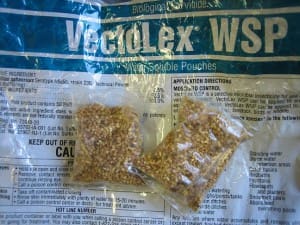Larvicide
The larvicide products used include Bacillus thuringiensis israelensis (Bti) and Bacillus sphaericus (Bs). Bti and Bs are naturally occurring organic microbes found in soil and offer the most environmentally friendly method of mosquito control as they are very effective against mosquitoes but have extremely few non-target effects.
Left to Right (Bti based products): VectoBac G granules (Label, SDS), VectoBac GS (Label, SDS), VectoBac GR (Label, SDS)
VectoBac 12AS (active ingredients: Bti and Bs, Label, SDS) is an aqueous solution product (no image available).
Vectolex WSP (active ingredients: Bti and Bs, Label, SDS)
Fourstar Briquets (active ingredients: Bti and Bs; Label, SDS)
Methoprene is a synthetic juvenile growth hormone, an exact mimic of hormones which are naturally inthe insects themselves. When applied to water where larvae are present, it prevents mosquito larvae from metamorphosing into adults.
Altosid XR briquettes (active ingredient: methoprene; Label, SDS)
Altosid Pellets WSP (active ingredient: (S)-Methoprene, Label, SDS)

Pupacide
When mosquitoes reach the non-feeding pupal stage, larvicidal products will no longer have any effect. We selectively use CocoBear when large amounts of pupae are present. It works by clogging the pupae’s breathing tubes.
CocoBear (active ingredient: mineral oil; Label, SDS)
Adulticide
The adulticide currently used by the NCMCD for area-wide ULV application is Zenivex (Label, SDS). It is applied by a truck mounted aerosol sprayer. The active ingredient is etofenprox. It is a synthetic pyrethroid which mimics pyrethrum, a naturally derived plant chemical from the chrysanthemum flower. The EPA lists Zenivex as a “reduced Risk” Product. Zenivex is approximately 200 times less acutely toxic to mammals than caffeine.
Available for municipal properties, a perimeter barrier treatment product, Mavrik (Label, SDS), or Suspend Polyzone (Label, SDS) is used. It is a synthetic pyrethroid that, once applied, provides a residual effect that may last a couple of weeks. It works by killing mosquitoes that land on treated surfaces of perimeter vegetation. Once dried, this product is non-toxic to honeybees.
Truck-mounted ULV sprayer







